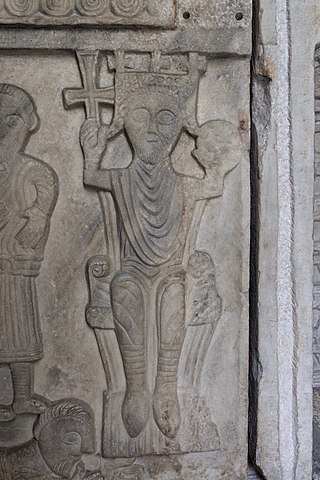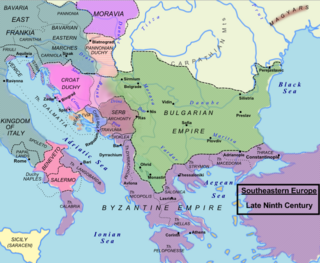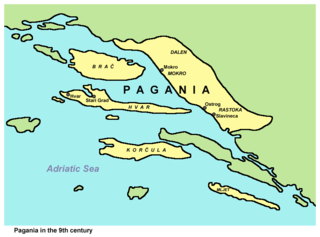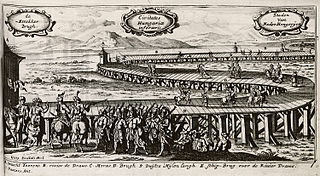Reign
Rise to power

In 879, "certain Slav of the name Branimir" reportedly had weak Duke Zdeslav, a supporter of the Byzantine Empire, killed near Knin in a rebellion that he led, per John the Deacon's Chronicon Venetum et Gradense (early 11th century). [2] [6] [8]
In the Epistolae Ioannis VIII are preserved five papal letters sent between 879 and 882. [7] During the solemn divine service in St. Peter's church in Rome in 879, Pope John VIII gave his blessing to the duke, his authority and the whole Croatian people and country about which he informed Branimir in the first letter. [7] The Pope brought the very decision on 21 May 879, and confirmed it in his letter on 7 June 879 (mentioning him as Dilecto filio Branimir [7] ). [5] As the blessing was reported by Pope himself twenty days later it probably had a great meaning for the time, recognizing Croatia as a relevant part of medieval Christian Europe, [7] and sovereign state. [2] In the third letter of the same month Branimir is once again mentioned (as principis ... Branimir), and the letter is titled to all honorable priests and all the people (Omnibus uenerauilibus/sacerdotibus et uniuerso populo). [7]
After 880, Branimir did not succumb to pressure of recognizing sovereignty of Charolingian Emperor Charles the Fat, even after the emperor made years long alliance with Venetians against Croatia. [4] In Branimir's time, Venetians had to pay taxes to Croatia and to the Narentines for their ships traveling along the eastern Adriatic coast, while the Dalmatian cities under Byzantium paid 710 ducats of tribute to the Croatian ruler. [2] [4] [9]

Throughout his reign, Duke Branimir worked on increasing his independence. According to the map of his contemporary, Saxon King Alfred the Great (871–899), the territory of "Dalmatia" was between the Adriatic Sea, Danube, "desolate lands", Bulgars and Achaia. [7] Branimir reigned until around 892. He was succeeded by Trpimir I's third son, Muncimir. [10]
Religious policy
At the time pope's commitment with Branimir is obvious intention to connect Croatian Church with the Holy See and Diocese of Rome, but also affirm old organization in the province of Dalmatia in which ancient Salona (then Split) was the metropolitan centre of Dalmatia. [7] In 880-882, Duke Branimir via Theodosius, the bishop of the Diocese of Nona (episcopus Croatorum [11] ) which was formed on initiation of Patriarchate of Aquileia, wrote to Pope John VIII affirming commitment to the Roman Papacy, and recognized the supreme ecclesiastical authority of the bishop of Rome. [7]

However, the situation complicated until 887 during the time of pope Stephen V (information is found in few letters and preserved in Decretum Ivonis and Decretum Gratiani Collectio Britannica). The previous archbishop of Split, Marin, died and Theodosius was promoted to the position by Aquileian patriarch Walpert in 886, but did not abolish Diocese in Nin as wanted by the Holy See, however, eventually in 887–888 was confirmed as the archbishop of Split (with a pallium). [7] Later after his death, Diocese of Nona once again will be temporary separated from the Archdiocese of Split. [11]
Under the influence of Methodus' baptising missions in 882 who made a stop in Croatia on his way from Moravia to Constantinople, Branimir possibly also endorsed parallel usage of Latin and Slavic in liturgy. [2] [4]
In 18th century Mensa episcopalis - Donationales from the archive of Archdiocese of Split is preserved a copy of the Hungarian-Croatian king Gejza charter (dated 1158, but probably a 13-14th century falsificate) in which are confirmed donation of village Srinjine in Mosor to Archdiocese of Split by "Branimir dux Chroatorum" (original probably was dated between 879–886). [7] The information is also related to Thomas the Archdeacon's Historia Salonitana (13th century) account about archbishop Marin and Branimir duke of "Sclavonia". [7]
He also undertook a pilgrimage to Cividale. His name is found in the Evangelistary of Cividale together with the name of his wife Mariosa (Branimero comiti, Mariosa cometissa; Croatian : Maruša or Marija). [13] [7] [14] [15]
Etymology and royal house
His name Branimir (with recorded variations Branimiri, Branimiro, Branimerus, Branimirus, Brannimerus, Branimero, Breanimir) is an old Slavic name, and could be translated as "defender of peace", as the verb brani- means to defend while word mir means peace in Slavic languages.[ citation needed ]
Unlike his predecessor and successor (both Trpimirović), some historians suggest that Branimir might be a member of the House of Domagojević, particularly, one of Domagoj's sons, but there's no certainty. [6]













